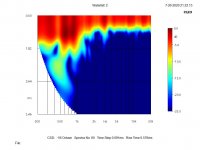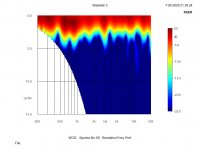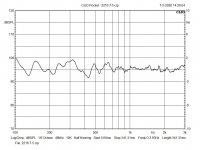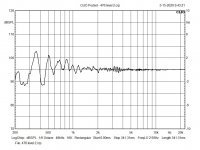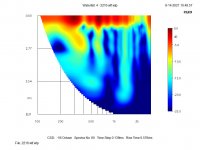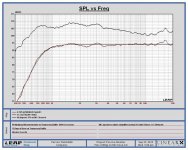I need to take measurements again but I think potentially the output from a large horn even down to the tuning note, outperforms that of a dynamic radiator. Judging by the csd times. The group delay bump at tuning can be fixed with phase eq. Ctc gets relaxed as you go lower it seems, as well.
I think potentially the output from a large horn even down to the tuning note, outperforms that of a dynamic radiator.
If you mean over the same bandwidth, then I would agree completely. It's really no contest for high SPL.
Does this mean you guys are saying that a CD on a (good) horn should be used as low as it is specified/designed for?
That that scenario represents better SQ, than maybe using a dynamic radiator to take some of the lower end load off the CD?
(all within linear, low distortion output of both CD and cone....not talking about any high SPL use)
That that scenario represents better SQ, than maybe using a dynamic radiator to take some of the lower end load off the CD?
(all within linear, low distortion output of both CD and cone....not talking about any high SPL use)
A high quality, i.e. powerful comp. driver is required. The Axi2050 definitely fall into that category.
Horn loading comes second but I'd stay away from low T horns as they generate significant amounts of throat distortion and beam like a laser.
The profile of the toot on the previous page is a borderline case.
Horn loading comes second but I'd stay away from low T horns as they generate significant amounts of throat distortion and beam like a laser.
The profile of the toot on the previous page is a borderline case.
Last edited:
Didn't you and I beat this subject to death ~100? pages ago? Anyway, in another thread I noted if you use a compression horn, then nowadays best to use it with a high XO point relative to its Fc to make it basically a WG; otherwise need to make your own huge WG to go low.
I want to buy a 1" driver that could work with a 12" driver and the HF108 seemed like a good choice.Don't get me wrong, I think the Tymphany is great value for money, but I don't think it's suitable for a 2 way that somewhat lives up to the thread title.
Until this year I considered the HF108(R) to be one of the most interesting 1" drivers and almost bought a pair.
The new Kartesion compression driver is interesting with a Magnesium diaphragm and less bumps in the impedance. The flat response in the spec sheet makes me wonder how they measured it.
Keyser has mentioned the BMS 4538 as having a good response, the 4544 and 4550 are similar just with increasing xmax to cross lower.
The 18 sound 1018BT in their new range also looks to have a very even response and a direct radiator like impedance.
Does anyone have any experience or thoughts on any of these or anything else?
Is there any literature or studies about the issue you report?... but I'd stay away from low T horns as they generate significant amounts of throat distortion...
.
Didn't you and I beat this subject to death ~100? pages ago? Anyway, in another thread I noted if you use a compression horn, then nowadays best to use it with a high XO point relative to its Fc to make it basically a WG; otherwise need to make your own huge WG to go low.
We did 😀 and yes, but it depends on one's objectives/requirements (as always).
I want to buy a 1" driver that could work with a 12" driver and the HF108 seemed like a good choice.
The new Kartesion compression driver is interesting with a Magnesium diaphragm and less bumps in the impedance. The flat response in the spec sheet makes me wonder how they measured it.
Keyser has mentioned the BMS 4538 as having a good response, the 4544 and 4550 are similar just with increasing xmax to cross lower.
The 18 sound 1018BT in their new range also looks to have a very even response and a direct radiator like impedance.
Does anyone have any experience or thoughts on any of these or anything else?
The HF108 is one of the better Faital Pro comp. drivers. Many happy users on this forum and a few critics.
The 12PR320 is the obvious partner for a 2 way that is almost full range.
Kartesian drivers look good on paper, but we have yet to see independent measurement data.
BMS 4538 & 4550 are safe bets and the latter is indeed suitable for a crossover below 1000 Hz.
But I would definitely opt for the much more recent and advanced 5530ND which was actually designed for a low XO point and currently a steal (original MSRP was > €230).
It seems 18Sound revised the 1018BT and the factory response looks indeed very good, almost to good to be true.
Another interesting driver is the ND1TP and the well known NSD1095 of course, that received a new diaphragm with vented poly surround a few years ago.
Is there any literature or studies about the issue you report?
I came across an article on this topic last week. I'll look it up.
Last edited:
That's why I'm wary of 'exotic' drivers from small manufacturers. There are countless examples where quality control leaves something to be desired, or where the buyer has to rely blindly on the promised specifications.
Here's an example of a compression driver where an uneven opening in the coil gap caused a scraping voicecoil.
I have at least 2 JBL 2450's similar to this..
Sadly, "small" or "exotic" isn't enough.
Member
Joined 2006
Any thoughts on beyma cp380m? Some say its easier to the ears compared to a few others.
And what about RCF ND-350? 🙂
And what about RCF ND-350? 🙂
I didn't get that battery =(....but I did work about 32 hours in the last two days....X0
O sh*t - sorry!! 🙂
//
I want to say that my meter is reading 12.5...not sure why this matters
So my guess is that BL basically effects efficiency and in turn, heat and potentially power compression if that were an issue. Unlikely issue in my case? My guess is that is not an issue....The resonance at 500hz is a thing....but the XO is already 400hz....when I get ahold of a real life 170hz HvDiff the XO may go even lower....
I think....the axi and my 350hz tractrix has better sound quality at 350hz than the 15m....I think....I'd have to take measurements to prove that...The only thing suffering more so for the horn is group delay. Thats my theory we'll say till I prove it with measurements...I also never seen measurements with the cabinet fully stuffed yet so theres that.
GM is usually right and the only thing I can think of is the 1.5X Fc rule. I'd like to see the direct energy CSD of your guy's woofers for reference. Is this even possible below where the room takes over btw? I forget...
So how does Acoustic Elegance have such a great reputation when non of you own the woofers lol....The design makes sense, the phase plug serves as a heatsink and the woofer circulating air around it, seems like a great idea....Hopefully there is something outside of BL that makes these woofers great because if a person lies about one thing, they'll lie about another. 25% lower BL is by design, not accident.
So my guess is that BL basically effects efficiency and in turn, heat and potentially power compression if that were an issue. Unlikely issue in my case? My guess is that is not an issue....The resonance at 500hz is a thing....but the XO is already 400hz....when I get ahold of a real life 170hz HvDiff the XO may go even lower....
Looking at the CSD wouldn't you agree that the decay times are much lower from a large compression driver and horn vs a large woofer....say a 4" diaphragm, 2inch exit with a 350hz horn vs 15" woofer....I feel like I've tried to start this debate with you before.... from the tuning note of the horn and up....the, on axis.... sound quality is higher from the horn....The resonate character of a dynamic woofer with matching source size is much less tame...If we were to compare a 4" dynamic woofer it might be much closer but the decrease in excursion via horn leaves less energy within the diaphragm to be dissipated...The air volume involved in the horn is better behaved than the mass of the large 15" woofer... When a horn gets big enough...this may change but I am not sure. For example, a large bass horn might not be a good choice to send midrange through?If you mean over the same bandwidth, then I would agree completely. It's really no contest for high SPL.
vsDoes this mean you guys are saying that a CD on a (good) horn should be used as low as it is specified/designed for?
That that scenario represents better SQ, than maybe using a dynamic radiator to take some of the lower end load off the CD?
(all within linear, low distortion output of both CD and cone....not talking about any high SPL use)
Didn't you and I beat this subject to death ~100? pages ago? Anyway, in another thread I noted if you use a compression horn, then nowadays best to use it with a high XO point relative to its Fc to make it basically a WG; otherwise need to make your own huge WG to go low.
I think....the axi and my 350hz tractrix has better sound quality at 350hz than the 15m....I think....I'd have to take measurements to prove that...The only thing suffering more so for the horn is group delay. Thats my theory we'll say till I prove it with measurements...I also never seen measurements with the cabinet fully stuffed yet so theres that.
GM is usually right and the only thing I can think of is the 1.5X Fc rule. I'd like to see the direct energy CSD of your guy's woofers for reference. Is this even possible below where the room takes over btw? I forget...
So how does Acoustic Elegance have such a great reputation when non of you own the woofers lol....The design makes sense, the phase plug serves as a heatsink and the woofer circulating air around it, seems like a great idea....Hopefully there is something outside of BL that makes these woofers great because if a person lies about one thing, they'll lie about another. 25% lower BL is by design, not accident.
This quote from John is just more smoke and mirrors to me...So you display thiele specs that represent unrealistic user end possibility. Nice. The driver on the youtube video had the same exact resonances in the impedance plot. Get Real.I built a heavy steel cage out of 2x2 square tubing, 3/16" wall thickness to securely attach woofers to when taking measurements. It was the only way I could duplicate the same measurements that Nick from Lambda Acoustics had shown since back in 1999/2000.
Last edited:
I think....the axi and my 350hz tractrix has better sound quality at 350hz than the 15m....
When you eventually build, you're going to want an active XO/DSP to listen and measure. One of my previous builds with the waveguide loaded PRV 5MR450-NDY could have its XO swept between 300hz and 4khz without much noticeable difference, but you won't know till you try it. Then you can start planning your passive XO
GM is usually right and the only thing I can think of is the 1.5X Fc rule. I'd like to see the direct energy CSD of your guy's woofers for reference. Is this even possible below where the room takes over btw? I forget...
Hello Camplo
Not sure if this is what you are looking for. I have CSD/Wavelet for my 2 way down to 200Hz. Crossover is at 700Hz 15" woofer Waveguide 4" CD. This is an in room un-gated measurement so the room is in it as well. I added Group Delay as well.
Rob 🙂
Attachments
Last edited:
It would be nice to see csd of the 2 drivers separate and un filtered to compare...
Otherwise burst decay would likely tell the story more clearly.
What is your horn cut off frequency
It's almost like I'm saying that fourth order bandpass it's better than sealed or fourth order alignments
Otherwise burst decay would likely tell the story more clearly.
What is your horn cut off frequency
It's almost like I'm saying that fourth order bandpass it's better than sealed or fourth order alignments
OK here are separately. Windows are not exact but close. Why are you concerned about separates when the system will be filtered and combined? JBL uses it @ 800Hz I went a bit lower to 700Hz or so. Depends on how you define cutoff. 700-750 is right on the knee so I am pushing things a bit.
Attachments
Last edited:
On second thought Rob, it looks like you do have two separate CSD plots of each driver and you can see that the horn as tighter Decay times
They look pretty close to me especially if you account for the different time scales. Certainly not enough difference to worry about. The 476 compression driver is the the one that looks "wider" shorter time scale. Actually I think the woofer looks a little better?
Rob🙂
Rob🙂
- Home
- Loudspeakers
- Multi-Way
- Is it possible to cover the whole spectrum, high SPL, low distortion with a 2-way?
